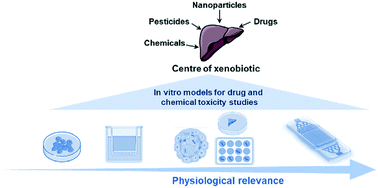Liver organ-on-chip models for toxicity studies and risk assessment
Abstract
The liver is a key organ that plays a pivotal role in metabolism and ensures a variety of functions in the body, including homeostasis, synthesis of essential components, nutrient storage, and detoxification. As the centre of metabolism for exogenous molecules, the liver is continuously exposed to a wide range of compounds, such as drugs, pesticides, and environmental pollutants. Most of these compounds can cause hepatotoxicity and lead to severe and irreversible liver damage. To study the effects of chemicals and drugs on the liver, most commonly, animal models or in vitro 2D cell cultures are used. However, data obtained from animal models lose their relevance when extrapolated to the human metabolic situation and pose ethical concerns, while 2D static cultures are poorly predictive of human in vivo metabolism and toxicity. As a result, there is a widespread need to develop relevant in vitro liver models for toxicology studies. In recent years, progress in tissue engineering, biomaterials, microfabrication, and cell biology has created opportunities for more relevant in vitro models for toxicology studies. Of these models, the liver organ-on-chip (OoC) has shown promising results by reproducing the in vivo behaviour of the cell/organ or a group of organs, the controlled physiological micro-environment, and in vivo cellular metabolic responses. In this review, we discuss the development of liver organ-on-chip technology and its use in toxicity studies. First, we introduce the physiology of the liver and summarize the traditional experimental models for toxicity studies. We then present liver OoC technology, including the general concept, materials used, cell sources, and different approaches. We review the prominent liver OoC and multi-OoC integrating the liver for drug and chemical toxicity studies. Finally, we conclude with the future challenges and directions for developing or improving liver OoC models.

- This article is part of the themed collection: Lab on a Chip HOT Articles 2022


 Please wait while we load your content...
Please wait while we load your content...